
|
Sale 8
Coin and Currency Auction
| Lot |
Photo |
Description |
Realized |
Lot 1719 |
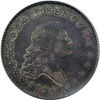 |
1794 Flowing Hair Half Dollar. . O-101. PCGS graded VF-30. This is the only "common" variety of this date, all others range from extremely scarce to unique. This coin boasts silvery gray toning on both sides, and an excellent strike. Adjustment marks appear very faintly around the tail of the eagle, with a few crossing lines noted in that area, none on the rims as usually seen. Only 23,464 were coined for the year, and very few are found in high grades, most seen are in grades of Very Good or below. Furthermore, these often are found with damage or other significant problems, not so here, the surfaces are excellent and undiminished by time. Luster remains near the devices, and we note the hair detail is outstanding for the grade assigned.
Later die state, with the ever-present crack from the rim near the first S of STATES to the eagle's wing, and another crack through OF. This one is not quite in the condition census, but fairly close to the lower end of EF-40.
Estimated Value $5,000 - 6,000.
Purchased 4/77 from Ed Hipps.
View details and enlarged photos
| Realized
$8,625 |
Lot 1720 |
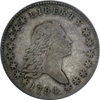 |
1794. Overton-102, Rarity-7. The Eliasberg Coin. . O-102. PCGS graded Fine-15. One of the truly rare coins of this important 1794 die variety collection. This one turned up in the Louis Eliasberg Collection sold by Bowers and Merena in April 1997. The Bust Half dollar condition census lists one coin that grades EF-40 of this variety, then the census drops to F-12 with two specimens at that grade. This one sneaks in just ahead at Fine-15 and stands alone as the second finest known of the die variety. Outstanding quality for a 1794 half, this one has lovely antique grayish brown on the obverse, a bit darker around the devices and lettering, the reverse with faint bluish and amber tones deepest near the devices. The obverse has some trivial adjustment marks, mostly on the right side running horizontally. As to the reverse, the fields and surfaces are clean and natural appearing. One tiny planchet impurity is noted at the end of the wreath on the upper right side, through the three leaves above the right wing of the eagle. A strong glass will note faint scratches but they are seen on every coin of this era in circulated grades. An excellent coin for the grade, and a foremost rarity in this state of preservation. This is the rarest collectible variety of the 1794s, the others (Per Sheridan Downey) like O-108 (4 known), O-109 (unique), O-110 (five known) and O-111 unique being rarer.
Estimated Value $10,000-UP.
From Bowers and Merena's Eliasberg Sale II, 4/97, lot 1661, and through various intermediaries.
View details and enlarged photos
| Realized
$14,950 |
Lot 1721 |
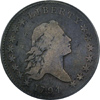 |
1794 Flowing Hair Half Dollar. . O-103. PCGS graded VG-8. This one is probably at the bottom end of the 6 coin condition census, the surfaces are very nice for the conservative grade, and although the eagle is diagnostically weak, he is clearly visible to the unaided eye. The peripheral lettering on the reverse is very strong. Medium silver gray in color, with lighter silver shades on the devices. Seldom offered, this rarity should command a nice premium over a common variety. Apparently an early die state as the die has not cracked at the third star when this one was struck.
Estimated Value $1,500 - 2,000.
Purchased from Julian Leidman, 9/91.
View details and enlarged photos
| Realized
$2,875 |
Lot 1722 |
 |
1794 Flowing Hair Half Dollar. . O-104. PCGS graded VG-8. This coin is probably about the tenth finest known of the variety, but it is one of the better examples to show the full reverse rim break above ER of AMERICA. The obverse break is noted at star three, but it does not continue to Liberty's chin and star eleven. Well balanced for the grade, with natural steel gray tones on the obverse, a dit darker on the reverse, which also has some old encrustations attached to several devices and lettering. Light adjustment marks extend through the eagle. Splendid rims and surfaces for the grade, and while more common than some of the other varieties offered of 1794, tough to find nice. A lovely example for the specialist.
Estimated Value $1,500 - 2,500.
Purchased from Paul Pritchett, 9/91.
View details and enlarged photos
| Realized
$2,990 |
Lot 1723 |
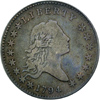 |
1794 Flowing Hair Half Dollar. . O-105. PCGS graded Fine-15. This coin boasts original toning and well struck devices. There are some very minor adjustment marks running horizontally through Liberty's head near her ear. Struck before the reverse die failed, which weakens the eagle at the central area, on this coin the eagle is fully struck. Two shallow dull marks are located just above the third stars outer point. To be extremely critical, there has been something expertly removed from the right obverse field, as the surfaces seem to show slightly more than the usual circulation disturbances. We suggest that a shallow scratch was removed from the chin to the fourteenth star in this area, as remnants remain and the surfaces have been smoothed there. Obviously, this work is very minor, and few would bother to mention it, and the PCGS graders didn't seem bothered by it either.
Once again, outstanding rims and devices for the issue, which is seldom found at all, and nearly impossible to locate in higher grades like this example. Don't be put off by the expert work done on this example, such things are far more common on coins of this grade than most people would dare to believe. This coin is certainly in the top six known, most of which have problems or other detractions. An opportunity.
Estimated Value $2,500 - 3,500.
Purchased from Sheridan Downey, 9/91.
View details and enlarged photos
| Realized
$4,600 |
Lot 1724 |
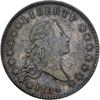 |
1794. 0verton-106, Rarity-6. . O-106. PCGS graded VF-25. This is the fifth finest known of the variety, just a notch behind a few others that grade 5 points higher. Excellent steel gray in color and well struck. We note minor weakness at the center of Liberty, mostly in and around her curls, and perhaps something was done in this area as fine scratches can be seen with a strong glass. As with all early coinage, great care must be taken during lot viewing to measure whatever faults are noted, in order to arrive at an approximate value. We note that the silver planchet shows roughness in its preparation. There are some trivial adjustment marks on the reverse that run just left of vertical through the right wing of the eagle. Wonderful rims and surfaces for the grade, examination will only show minor handling scratches.
This one is an early die state struck before the obverse die cracked through LI to the tenth star. Also, the reverse die does not show the crack near the first S of STATES seen on all O-101 variety coins (which were struck later with this same reverse die). An impressive example of this rare die variety! This sale offers the advanced variety specialist a chance to purchase some extremely rare Condition Census coins.
Estimated Value $5,000 - 6,000.
Purchased from Julian Leidman in 1992.
View details and enlarged photos
| Realized
$10,350 |
Lot 1725 |
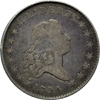 |
1794 Flowing Hair Half Dollar. . O-107. PCGS graded Fine-12. This is the nicest example to be auctioned in some time. It is tied with a few others at the lower end of the Condition Census, with the best seen a VF-25, and another single VF-20 coin below that. The next listing are the third finest known coins as Fine 12, which includes this example. The surfaces of this are quite nice, but we note a disturbance at the center of Liberty's hair, below and behind her ear where a mark or some other detraction was removed. There is also a circular stain on the back of Liberty's throat (this is not a silver plug) just below the center point of the coin, and this is likely the result of something that was stuck to the coin for years, like a small sticker. Faint adjustment marks can be seen between the letters of LIBERTY, and there is a very shallow dull scrape up from Liberty's head to the L. There are adjustment marks at the center of the reverse, criss-crossing the eagle. Wonderfully free of rim marks or other detractions, and with natural silvery gray toning, this coin is a delight to behold and perfect for the variety specialist who wants a high grade condition census example of the variety.
Estimated Value $3,500 - 5,000.
Purchased in March of 1992 from an unknown source.
View details and enlarged photos
| Realized
$6,613 |
Lot 1726 |
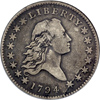 |
1794. 0verton-108, High Rarity-7. One of the Finest Known of the Variety. . O-108. NGC graded VF-20. This is one of the finest of only 4 known of this extremely rare variety. The obverse die broke quickly with a heavy die crack from the rim near the 4 in the date up through the last 4 stars, this crack must have terminated the obverse dies use. As this variety was struck with the same reverse as the common O-101 variety, it is worth noting that the O-108 die variety was struck first, as there is no reverse die crack near the first S of STATES, this die crack is present on all O-101 coins. The finest specimen is believed to be in the collection of Robert P. Hilt II, who authored a controversial study involving die group strength that was published in 1980. In that study Hilt photographed a splendid example of this variety, which does not appear to have the obverse die break. The coin he photographed must grade EF 40. The others known are the coin offered in this lot, one grading Fine 12 plated in the 1993 Parsley-Overton Third Edition, and one other low grade specimen.
The surfaces here are average for the grade, we note minor adjustment marks around the obverse periphery, with a few minor adjustment marks in Liberty's hair near her ear. Examination will note that the rims are clean, free of the usual distracting bumps or bruises, and the fields and devices show typical handling marks expected for coins of this era. Medium gray color in the fields combines with lighter silver on the devices, giving good contrast to the coin. One of the most exciting coins in this sale for an advanced numismatist to pursue, and once sold, will likely not be offered again anytime soon. This is the first (and only) auction appearance of this die variety and a foremost opportunity for the advanced die variety specialist.
Estimated Value $10,000-UP.
Purchased in June of 1999 from an unknown source.
View details and enlarged photos
| Realized
$16,100 |
Lot 1727 |
|
1795 Flowing Hair Half Dollar. . O-116. PCI graded VG-8. Medium silvery gray as usually seen for the date. The rims are still separated from the lettering and stars.
Estimated Value $475 - 525.
View details
| Realized
$633 |
Lot 1728 |
 |
1795. Overton-132. Rarity-8. One of two known of the variety. . O-132. NGC graded VG-10. Numismatists for the last 150 years have accumulated coins and medals in America. Scholarly works began to appear in the late 1850s on die varieties of United States large cents. Other denominations were studied, and two students of the time, J. Colvin Randall and Capt. John W. Haseltine examined available collections of the day and published a die variety reference on United States quarters, half dollars and silver dollars, under Capt. Haseltine's name (Randall apparently never forgave Haseltine for claiming the work as his alone). The Haseltine work was the standard reference for these silver varieties for about 5 decades. In time, collectors began to find new varieties, and a new wave of updated variety books was published in the 1920s and later. M. L. Beistle published an excellent work on half dollar varieties in 1929, based on his own collection, the collection of David Proskey and Mr. E. H. R. Green. The Beistle book stood as the standard reference until the 1960s, when Al Overton published his own study of early half dollar die varieties, along with subsequent revisions and updates. The Beistle book proved to be very accurate, but lacked the plates of later varieties desired by collectors.
One die pairing of 1795 half dollars proved to be very troubling. Beistle noted on page 10 of his book under variety 1795 10 C that …"This die variety is very similar to Nos. 1, 2 and 6. The last star point is close to the end of the bust, and the first star and curl are in the same position as on No. 2. This variety can readily become confused with No. 6, but there is one very decided difference. On No. 6, E and R in LIBERTY are wide spaced, and on this variety they are close spaced, and almost touch at the base." Beistle goes on to say "Exceedingly rare; the only one I have seen and believe it to be unique."
Beistle printed plates of the 1794 and 1795 half dollars, as well as other selected varieties. Included in these plates is a photograph of his 10 C variety, the coin he thought to be unique. Beistle's 1795 variety 10 C is important because his obverse 10 was not paired with any other known reverses, while reverse C was used in 1795 to produce Beistle's 1 C variety (Overton-101) which is extremely rare, with only 5 specimens known of the B 1-C or O-101 variety. When Overton published his variety reference on half dollars, he initially dropped Beistle 10 C as he could not locate a specimen, and none of the half dollar collectors he knew had ever seen one. Later, in his second 1970 edition, Overton included 1795 Beistle 10 C as Overton-132, and used the same photograph to represent the variety that Beistle has used.
In 1990, the Third Edition of Early Half Dollar Die Varieties, 1794 - 1836 was published by Don Parsley, updating the Overton reference with a condition census and additional varieties discovered since 1970. Despite years and years of dozens of collectors actively attributing bust half dollars, no one had found the original Beistle 10 C coin, nor had anyone turned up another example. Doubts had begun to form about the Beistle 10 C. Parsley stated after the variety description of 1795 Overton-132 "If in fact, this marriage exists, this piece may be unique. Any information the reader may have would be welcome." Another decade passed, thousands and thousands of bust half dollars were attributed, purchased and sold. Still no example of the 1795 Beistle 10 C (O-132) was located, despite the best efforts of the Bust Half Nut variety collectors club.
The decades of speculation were finally laid to rest in July of 2000, Southern California coin dealer Manny Acosta purchased a 1795 half dollar from a customer in his store. Acosta called half dollar specialist Gary Beedon and asked him to help him attribute his new purchase. Beedon and Acosta soon discovered that the new 1795 half dollar was an example of Beistle 10 C, or Overton 132. To say the discovery was exciting is a serious understatement. Not only did this coin confirm that O-132 did exist, but the example found was different from the coin pictured in Beistle's book. To locate a variety which has been unconfirmed for over 70 years is certainly the find of a lifetime. For bust half dollar collectors, this is one of the most important finds in decades.
As to the coin itself, it is generally untoned and silvery-white in color. The obverse has typical marks expected for the grade, but the rims and surfaces show no significant defects or circulation problems. On the reverse, the unique berry combination 10 on the left branch and 9 on the right quickly identify this as Reverse A (Overton) or C (Beistle). Note that there are four berries on the lower right branch under the wing, both outside berries are small and partially covered by the branch. Well struck by the dies, this coin is quite pleasing for its moderate grade. The obverse die failed quickly, with a strong die break through RTY of LIBERTY. So far as is known, only two coins survived, one of which hasn't been published since 1929, and this example. To say this is a foremost opportunity would be an understatement. This is the opportunity to purchase this variety. Once sold, it may not be offered again for decades unless the buyer from this sale decides to part with it. No hint of a third example has been heard.
After reviewing the Beistle reference, the cataloger (JMM) noticed a small but very important clue pertaining to the Beistle 10 C coin. Beistle noted in his Foreword that his collection was formed with the help of David Proskey and Mr. E. H. R. Green. Beistle notes that through Proskey, Beistle was able to "possess and register many of my rarest varieties, not a few of which came from his private collection." It thus appears that Proskey sold Beistle coins for his collection, including pieces from Proskey's own private collection. Although Beistle did not auction his personal collection, some of the coins used in his plates have turned up in half dollar collections, and it is likely that Beistle's coins were sold sometime after his book was published in 1929 although the disposition of his collection was not published or auctioned.
Reading on Beistle continues in his Foreword as follows:
"This work would not have been brought up to its present completeness had it not been for my friend Mr. E. H. R. Green of South Dartmouth, Mass., who is an ardent collector as well as an advanced student of numismatics. I am very much indebted to Mr. Green for loaning me his entire collection of Half Dollars for checking die varieties, which enabled me to make this work more complete than otherwise. At the same time, it gave me an opportunity when making my plates, to photograph some of his finest and rarest specimens."
My guess is that Beistle did not own the example of 10 C, but that it resided in the Green collection. Further evidence supports this in the fact that the plate for 1795 obverse 10 is dropped in seemingly as an afterthought, on page XXV after the 1796-97 half dollars. Note that all other half dollars plated are in date, variety and letter order. Obverse 1795 10 is the one exception to proper sequential ordering. Let me emphasize what Beistle says in the paragraph about Col. Green. Beistle states that his book was "brought up to its present completeness" by coins Green "loaned" him. Further, Beistle thanks Green for allowing him to "photograph some of his finest and rarest specimens." As the Beistle collection was apparently sold or broken up, yet the 1795 10-C has not turned up, there is certainly a better than average chance that the coin used in his book resides in the Col. Green collection. Based on the location of the 1795 Beistle 10 obverse in the plates, it appears that it turned up very late in the publication process, and barely made it into the Beistle book. The Col. Green collection was broken up in the 1940s, with some of the more important coins sold directly to a famous mid west collector, where they remain to this day. With no evidence to the contrary, it is likely that the long missing 1795 Beistle 10-C, Overton-132 coin is held in that famous collection today. This would explain why the coin hasn't turned up in over 70 years.
Now at last, a second specimen has turned up, the specimen offered here. Rumors of the demise of Beistle's 1795 10-C were exaggerated, and at last all collectors will have a chance to finally purchase this coin for their variety collections. When the hammer falls, there will be one very happy collector who can finally knock this coin off their want list, after decades of uncertainty and searching, the existence of Beistle 10 C is finally solved.
Estimated Value $25,000-UP.
Purchased over the counter by Manny Acosta at his Southern California coin shop July 25, 2000, and consigned to this sale.
View details and enlarged photos
| Realized
$39,100 |
Lot 1729 |
|
1802 Draped Bust Half Dollar. . O-101. PCGS graded EF-45. One of the finest graded of this rare date, PCGS has yet to grade any as Mint State! In fact, only 5 have been graded as EF-45, and 7 graded higher in various AU grades. This one has lovely umber colors on both sides, with full and complete curls on Liberty, strong stars and clean surfaces. Similar on the reverse, trouble free wear (what little wear there is) and very well balanced. As a date, 1802 half dollars were not saved, virtually all entered circulation and stayed there for years, with few today known in high grades. If you are a date or variety collector, then you would do well to purchase this lovely coin for your collection. This exact coin sold for in excess of $4,200 to a collector a few years ago, and could be worth more today. As a date, this is very under appreciated and downright rare in this condition. Expect worthy competition to capture this prize.
Estimated Value $3,000 - 4,000.
View details
| Realized
$3,910 |
Lot 1730 |
|
1806 Draped Bust Half Dollar. Pointed 6, stem through claw. . O-118. EF-45. Earlier die state of the reverse, with only a faint crack up from the lower rim to the arrows. Light silvery gray surfaces and no doubt carefully cleaned in the past, still with a hint of luster and well struck.
Estimated Value $500 - 700.
View details
| Realized
$776 |
Lot 1731 |
|
1807 Draped Bust Half Dollar. PCI graded Fine-12 Scratched. There is a minor "X" scratched through the date.
Estimated Value $100 - 125.
View details
| Realized
$104 |
Lot 1732 |
|
1807 Capped Bust Half Dollar. Large stars, 50 over 20. A small group of bust half dollars, all PCI graded as follows: 1807 GD-4 Nicked Rim; 1823 VG-10 Scratched and 1828 VF-25. All appear to have been cleaned, the 1823 has small minor pin scratches, and the 1828 is the best of the lot. Lot of 3 coins.
Estimated Value $75 - 100.
View details
| Realized
$115 |
Lot 1733 |
|
1807 Capped Bust Half Dollar. Large stars, 50 over 20. . O-112. AU-53. Gunmetal gray in color and with lovely eye appeal throughout. Hints of luster near the devices. Cleaned long ago, and the surfaces show wipe lines, as seen on virtually all circulated coins of the period. Well struck and preserved, with the 50 over 20 feature visible with a glass.
Estimated Value $1,000 - 1,500.
View details
| Unsold |
Lot 1734 |
|
1808/7 Capped Bust Half Dollar. . O-101. AU-55. A scarce overdate in this high of grade, this one boasts rose colored luster and light toning. There is a scratch down Liberty's mouth into her hair, and another down her neck into her hair to the rim. Well struck.
Estimated Value $600 - 700.
View details
| Unsold |
Lot 1735 |
|
1812 Capped Bust Half Dollar. Normal date. . O-110. AU-50. Steel gray in color and well struck. Washed out from too many cleanings in the past, but the surfaces are defect free and the coin shows little wear from circulation.
Estimated Value $200 - 250.
View details
| Realized
$322 |
Lot 1736 |
|
1814 Capped Bust Half Dollar. Normal. . O-105a. MS-60. One of the rare die states that is extremely popular with collectors, this "single leaf" is the result of die polishing to remove clash marks, which completely removed one of the leaves from the upper pair on the reverse. Similar to the 1937-D 3 legged nickel, which was caused by the same process. Dies often clash and become worn as they are used. Further use often creates cracks, which extend from device to device as the dynamics of striking pressure literally breaks apart the die. As more coins are struck, the dies frequently clash together without a planchet to soften the blow, and thus the dies impart their designs on each other (clash marks) normally in the fields. This obverse die clashed so hard that the shield lines are visible around Liberty's ear, but no trace of her ear is noted within the shield lines.
This coin has some minor scratches above the eagle, and trivial hairlines in the fields from a past cleaning. Delicate gold and blue toning around the periphery, with abundant eye appeal on both sides. Don't miss out on this rarity.
Estimated Value $700 - 1,200.
View details
| Realized
$1,380 |
Lot 1737 |
|
1821 Capped Bust Half Dollar. . O-105a. VF-20. Some planchets streaks near Liberty's mouth and into the field to the rim. Luster near the stars, and with red shades of color, probably from a retoning.
Estimated Value $40 - 60.
View details
| Realized
$58 |
Lot 1738 |
|
1822 Capped Bust Half Dollar. Each grades Good to Fine. The 1822 has a scratch down Liberty and another on the reverse. Lot of 3 coins.
Estimated Value $90 - 110.
View details
| Realized
$109 |
Lot 1739 |
|
1823 Capped Bust Half Dollar. Normal. . O-107. AU-53. Sharply struck, in fact Liberty has a double profile from her nose to her chest. Lovely antique blue and gold toning around the periphery and with frosty luster in the fields. Minor handling marks, and no problems whatsoever.
Estimated Value $275 - 350.
View details
| Realized
$345 |
Lot 1740 |
|
1824 Capped Bust Half Dollar. . O-105. PCGS graded AU-58. Flashy luster and well struck, but flat on the stars as usual. There is colorful peripheral toning on the lower obverse.
Estimated Value $200 - 250.
View details
| Realized
$391 |
Lot 1741 |
|
1830 Capped Bust Half Dollar. Small 0. These each grade EF to AU. The 1856-O has a repunched date up to the right (Breen-4869). Each is a nice coin, good for a type set. Lot of 3 coins.
Estimated Value $200 - 250.
View details
| Realized
$288 |
Lot 1742 |
|
1834 Capped Bust Half Dollar. Large date, small letters. . O-107. MS-61. Mottled gold and gray toning in the fields, with loads of luster beneath. A touch weak on the eagle's wing, but with clean rims and no handling problems which often plague this issue.
Estimated Value $300 - 350.
View details
| Realized
$414 |
Lot 1743 |
|
1834 Capped Bust Half Dollar. Small date, stars and letters. . O-121. PCGS graded AU-53. With a small drift mark in the planchet up in the field above Liberty's bust through the second star. Frosty luster and nicely toned with gold around the edges. One small mark at the base of the left foot of the N of UNITED. Flashy luster and well struck, certainly one of the better coins known of this variety.
Estimated Value $150 - 250.
View details
| Realized
$219 |
Lot 1744 |
|
1836 Capped Bust Half Dollar. Reeded edge. AU-53. One of just 1,200 struck, this rare issue has been sought-after by generations of collectors. This one has been cleaned and is still a bit too bright, and there are hairlines on the surfaces. One small scrape is noted before Liberty's neck. A coin that could be toned down and made more presentable.
Estimated Value $1,500 - 2,000.
View details
| Realized
$2,398 |
Lot 1745 |
|
1836 Capped Bust Half Dollar. Reeded edge. AU-50. A rare issue, thought to be one of the first coins struck on the Mint's new steam press, which improved efficiency and striking quality. Only 1,200 were struck, and many entered circulation so this is probably not a regular pattern issue. This one has been cleaned, with the resulting hairlines in the fields, and some minor scratches visible with a glass.
Estimated Value $1,500 - 2,000.
View details
| Realized
$2,398 |
Lot 1746 |
|
1836 Capped Bust Half Dollar. Lettered edge. . O-117. NGC graded MS-63. This one has an arc of deep blue toning along the lower obverse, a bit more organized in the toning department on the reverse, with beautiful deep blue around the periphery, rose at the centers. Vibrant luster and probably well up in the Condition Census for the variety. Well struck, with the entire scroll strong.
Estimated Value $900 - 1,000.
View details
| Realized
$1,150 |
Lot 1747 |
 |
1837 Capped Bust Half Dollar. PCGS graded MS-63 Premium Quality. Glowing luster and with lovely toning for the issue. This coin certainly has the appearance of a higher grade, and should inspire most collectors to bid accordingly. Weak on some of the peripheral stars, as usual, and with a few stray hairlines.
Estimated Value $1,300 - 1,600.
View details and enlarged photos
| Realized
$2,875 |
Lot 1748 |
|
1837 Capped Bust Half Dollar. MS-60. This one has been cleaned to a frosty brightness, there are some minor hairlines in the fields and a small neck nick. It appears that something was removed from above the denomination on the reverse. This coin is in a "U.S. Rare Coin Certification & Trading Co., Inc." holder (whatever that is) as MS-63.
Estimated Value $450 - 550.
View details
| Realized
$748 |
Lot 1749 |
|
1837 Capped Bust Half Dollar. MS-60. This one has satiny surfaces probably from an old cleaning, and one small grease mark in the planchet on the eleventh star into the field above. Interesting die cracks, and well struck throughout.
Estimated Value $450 - 550.
View details
| Realized
$575 |
Lot 1750 |
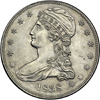 |
1838 Capped Bust Half Dollar. MS-63. This coin has been carefully filed around the rim and inspection is recommended. Satiny luster and well struck. The surfaces show no toning and the hair detail is full and complete. There are some hairlines in the fields. Much better than we make it sound, so check it out for yourself.
Estimated Value $1,000 - 1,250.
View details and enlarged photos
| Unsold |
Lot 1751 |
|
1838 Capped Bust Half Dollar. PCGS graded MS-62 Premium Quality. A frosty mint state coin that boasts mint-fresh luster and gold toning on both sides. An important type coin that is housed in the old style small PCGS holder.
Estimated Value $600 - 800.
View details
| Realized
$1,380 |
|
|